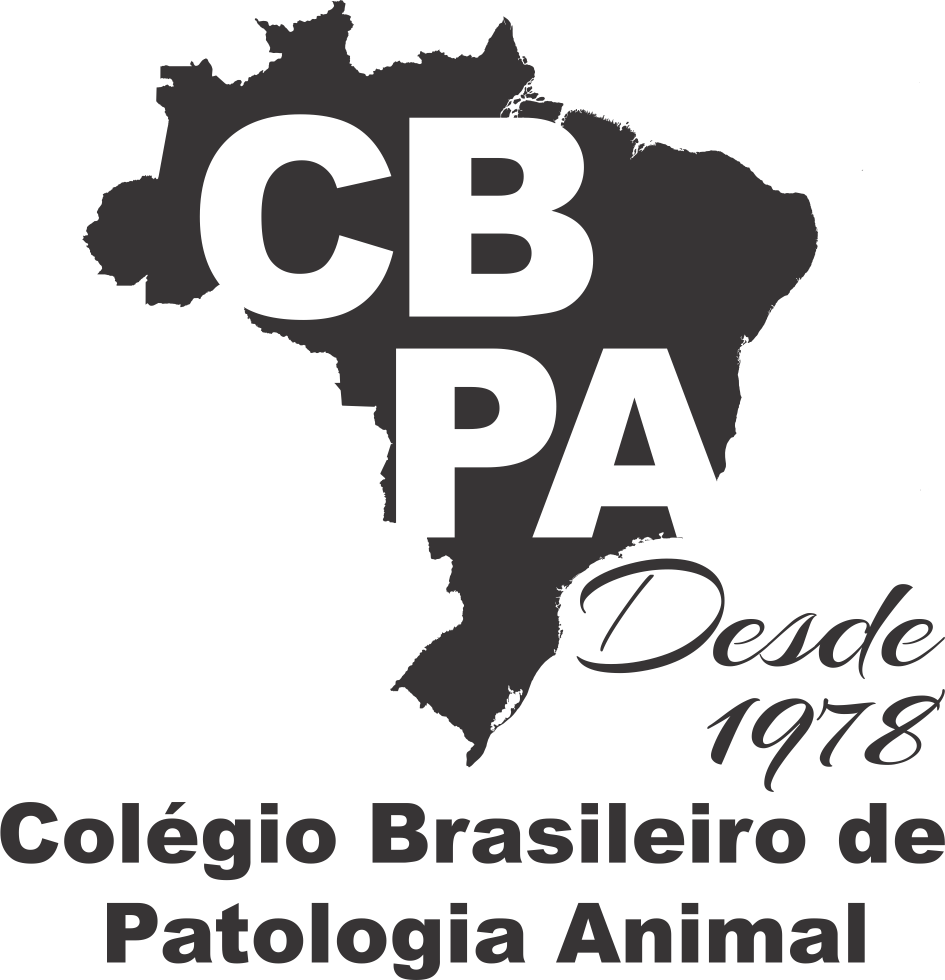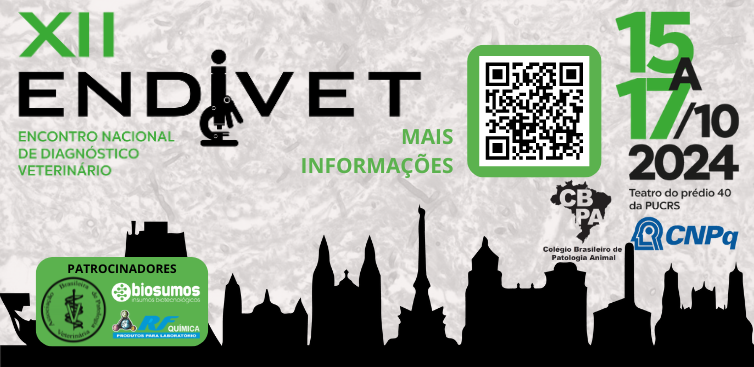Resultado da pesquisa (45)
Termo utilizado na pesquisa male
#1 - Male reproductive tract disorders in equids: 87 cases (2014-2022)
Abstract in English:
Male reproductive tract disorders (MRTDs) are common in equids and may represent a significant proportion of the caseload of equine practitioners. Herein, we determined the frequency, clinico-pathological findings, and therapeutics of MRTDs in equids from a 9-year survey of the clinical records of a Veterinary Teaching Hospital in Midwestern Brazil. During this period, 87 affected equids presented 100 MRTDs distributed in 17 different diagnoses. Forty-three (49.4%) equids presented MRTDs affecting the glans penis or preputial skin fold. Testicles, scrotum, and spermatic cords disorders were diagnosed in 32 (36.8%) horses. Of the remaining 12 (13.8%) horses, six presented two different MRTDs on two distinct anatomical areas, and five animals exhibited the same disease, affecting two different anatomical locations. Only one horse presented three distinct MRTDs on two anatomical regions. Habronemiasis was the most frequent MRTD detected in 26% of the diagnoses, followed by miscellaneous wounds (14%), cryptorchidism (13%), inguinal hernia (13%), funiculitis (9%), paraphimosis (6%), squamous cell carcinoma (5%), urethrolithiasis (3%), preputial abscesses, and orchitis (2% each). Phimosis, ulcerative posthitis, epididymitis, hydrocele, papillomatosis, teratoma, and testicular torsion accounted for 1% each. Sixty-three (72.5%) equids received hospital discharge, 18 (20.6%) were humanely euthanized, and six (6.9%) died. This study detected the most relevant MRTDs that affected over 7.5% in a survey of 1,154 equids referred for hospital care. Our finding highlights that MRTDs may be debilitating and life-threatening conditions, and they can potentially impact the reproduction of equids in the region. This knowledge may support equine practitioners in elaborating proper sanitary and management protocols to prevent and reduce the incidence of most MRTDs recorded, improving equid production and welfare.
Abstract in Portuguese:
Distúrbios do trato reprodutivo masculino (DTRMs) são comuns em equídeos e podem representar uma proporção significativa da casuística de hipiatras. Determinamos a frequência, os achados clínico-patológicos e a terapêutica de DTRMs em equídeos a partir de um levantamento de nove anos dos registros clínicos em um Hospital Veterinário no Centro-Oeste do Brasil. Nesse período, 87 equinos afetados apresentaram 100 DTRMs distribuídos em 17 diagnósticos diferentes. Quarenta e três (49,4%) equídeos apresentaram DTRM afetando a glande peniana ou pregas de pele prepucial. Distúrbios dos testículos, escroto e cordão espermático foram diagnosticados em 32 (36,8%) equinos. Dos 12 (13,8%) equinos restantes, seis apresentaram dois DTRMs diferentes em duas áreas anatômicas distintas, e cinco animais exibiram a mesma doença em duas localizações anatômicas diferentes. Apenas um cavalo apresentou três DTRMs distintas em duas regiões anatômicas. A habronemíase foi a DTRM mais frequente detectada em 26% dos diagnósticos, seguida por feridas diversas (14%), criptorquidismo (13%), hérnia inguinal (13%), funiculite (9%), parafimose (6%), carcinoma de células escamosas (5%), uretrolitíase (3%), abscessos prepuciais e orquite (2% cada). Fimose, postite ulcerativa, epididimite, hidrocele, papilomatose, teratoma e torção testicular representaram 1% cada. Sessenta e três (72,5%) equídeos receberam alta hospitalar, 18 (20,6%) foram sacrificados humanitariamente e seis (6,9%) morreram. Este estudo detectou as DTRMs mais relevantes que afetaram 7,5% dos pacientes em um levantamento de 1.154 equídeos encaminhados para atendimento hospitalar. Este achado destaca que as DTRMs podem ser condições debilitantes e com risco de morte, e podem impactar potencialmente a reprodução de equídeos na região. Este conhecimento pode ajudar os hipiatras a elaborar protocolos sanitários e de manejo adequados para prevenir e reduzir a incidência da maioria das DTRMs registradas, melhorando a produção e o bem-estar dos equídeos.
#2 - A comparative analysis of anatomopathological features and COX-2 expression of mammary neoplasms with malignant mesenchymal components in female dogs
Abstract in English:
Canine mammary neoplasms with malignant mesenchymal components, such as carcinosarcomas and sarcomas, belong to an uncommon and histologically heterogeneous group. Little is known about the biological behavior of these histogenic variants. This study aimed to compare the clinicopathological characteristics and the COX-2 immunohistochemical expression of different histologic subtypes of carcinosarcomas and sarcomas. Samples of 23 carcinosarcomas and 15 sarcomas from the mammary glands of female dogs were studied. Medical records were reviewed to obtain clinical data. Subsequently, histology microscope slides were analyzed to assess for mesenchymal subtypes, necrosis, vascular invasion, histologic grades, and lymph node metastasis. Immunohistochemistry was used to assess the COX-2 expression. The malignant mesenchymal proliferation was categorized into osteosarcomas (23/40), fibrosarcomas (5/40), liposarcomas (6/40) and chondrosarcomas (4/40). The osteosarcomatous differentiation was the most predominant type among the sarcomas and carcinosarcomas and was associated with vascular invasion (P=0.010) and lymph node metastases (P=0.014). High COX-2 expression was detected in 14.3% of the carcinosarcomas (carcinoma and/or sarcoma cells) and 27.3% of the sarcomas. The carcinosarcomas and sarcomas had similar clinical and pathological characteristics and developed as large tumors, with intratumoral necrosis and a predominance of high histologic grades, although the frequency of vascular invasion and lymph node metastasis was low. Osteosarcoma subtypes presented more aggressive characteristics than non-osteosarcoma subtypes.
Abstract in Portuguese:
Neoplasias mamárias caninas com componentes mesenquimais malignos, como carcinossarcomas e sarcomas, são um grupo de neoplasias pouco frequentes e histologicamente heterogêneas e pouco se sabe sobre o comportamento biológico das variantes histogênicas. O objetivo desse estudo é comparar as características anatomopatológicas e a expressão imunoistoquímica de COX-2 de diferentes subtipos histológicos de carcinossarcomas e sarcomas. Foram estudados 23 carcinosarcomas e 17 sarcomas da glândula mamária de cadelas. Os prontuários médicos foram revisados para obtenção de dados clínicos. Posteriormente, as lâminas histológicas foram avaliadas para acessar os subtipos mesenquimais, necrose, invasão vascular, grau histológico, metástase linfonodal. A imunoistoquímica foi realizada para avaliar a expressão de COX-2. Os tipos encontrados de proliferação mesenquimal maligna foram osteossarcoma (23/40), fibrossarcoma (7/40), lipossarcoma (6/40) e condrossarcoma (4/40). A diferenciação osteossarcomatosa foi predominante entre os sarcomas e carcinossarcomas e foi associado com invasão vascular (P=0,006) e metástase linfonodal (P=0,014). Uma expressão alta de COX-2 foi detectada em 14,3% dos carcinossarcomas (células carcinomatosas e/ou sarcomatosas) e 27,3% dos sarcomas. Os carcinossarcomas e sarcomas apresentaram características clínicas e patológicas semelhantes e se desenvolveram como tumores grandes, com necrose intratumoral e predomínio de alto grau histológico, mas com baixa frequência de invasão vascular e metástase distante. Os subtipos osteossarcomatosos apresentaram características mais agressivas quando comparados com subtipos não osteossarcomatosos.
#3 - Oxidative stress in female dogs with mammary neoplasms
Abstract in English:
The result of the reaction of free radicals with biomolecules is the formation of substances with the potential of inducing oxidative damage, a condition known as oxidative stress. There are voluminous literature data reporting the association, both as a cause and as a consequence, between different diseases and oxidative stress. In this study, 144 female dogs with mammary neoplasia were analyzed. The animals were submitted to clinical evaluation for disease staging, hematological evaluation, serum biochemistry (renal and hepatic function tests), and dosage of the oxidative damage biomarker, malondialdehyde (MDA), at the time of its approach and 30 days after treatment. A control group of 100 healthy animals was also submitted to determination of serum MDA levels. The mean age of the animals affected by mammary neoplasms was 9.88±2.95 (4 to 14) years, while in healthy animals it was 2.31±1.90 years (1 to 6). Of the 144 animals, 113 (78.9%) had malignant neoplasms, and 15, 21, 46, 17 and 14 animals were in clinical stage I, II, III, IV and V respectively and the carcinoma in a mixed tumor was the most frequent histological pattern in this group (26%). Thirty-one animals were diagnosed with benign neoplasms and mammary adenoma was the most frequent histological pattern in 15 animals (51.61%). Hematological changes in the preoperative period were observed in 44 (38.9%) and 12 (38.7%) animals with malignant and benign neoplasias, respectively, and there was a positive correlation between anemia and higher levels of MDA (P=0.0008) for animals with malignant tumors. Regarding serum biochemical parameters, the most frequent alterations in animals with malignant neoplasms were elevated ALT levels in 12 animals (10.6%), creatinine in 10 animals (8.84%) and urea in eight animals (7.07%). Females with benign neoplasms presented less occurrence of changes in these parameters. In the group of healthy animals (control), the mean serum MDA values were 12.08±4.18, whereas in the pre-treatment group, mean MDA was 24.80±5.74 for bitches with benign neoplasms and 32.27±10.24 for bitches with malignant tumors. A significant increase (P<0.001) in MDA levels was observed in animals with malignant mammary neoplasms when compared to healthy animals and with benign tumors. In addition, a significant reduction (P<0.001) was observed 30 days after treatment in MDA levels (27.37±7.86) in animals with malignant tumors. In conclusion, our results indicate an association between MDA seric levels and mammary neoplasms in dogs. The results suggest that this factor can be used as a biomarker of oxidative stress with a potential impact in the prognostic of mammary tumors, since significantly higher levels of MDA were detected especially in dogs carrying malignant tumors and presenting anemia.
Abstract in Portuguese:
O resultado da reação de radicais livres com biomoléculas é a formação de substâncias que podem ser utilizadas como marcadores de dano oxidativo, condição mais conhecida como estresse oxidativo. Evidências científicas comprovam a relação, quer como causa, quer como consequência, entre muitas doenças e o estresse oxidativo. Neste estudo, 144 cadelas portadoras de neoplasia de mama, foram submetidas à avaliação clínica para estadiamento da doença, avaliação hematológica, testes de função renal e hepática e dosagem do biomarcador de dano oxidativo, malondialdeído (MDA), no momento de sua abordagem e 30 dias após realização de tratamento. Um grupo controle de 100 cadelas saudáveis foi submetido também à determinação dos níveis séricos de MDA. A idade média dos animais acometidos por neoplasias mamárias foi de 9,88±2,95 (4 a 14) anos, enquanto que nos animais saudáveis foi de 2,31±1,90 anos (1 a 6). Dos 144 animais, 113 (78, 9%) apresentavam neoplasias malignas, sendo que 15, 21, 46, 17 e 14 animais encontravam-se em estadiamento clínico I, II, III, IV e V respectivamente, e o carcinoma em tumor misto foi o padrão histológico mais frequente neste grupo (26%). Trinta e um animais tiveram diagnóstico de neoplasias benignas, sendo que 7 estavam no estádio I, 16 no estádio II e 8 no estádio III e o adenoma mamário foi o padrão histológico mais frequente em 15 animais (51,61%). Alterações hematológicas no período pré-operatório foram observadas em 44 (38,9%) e 12 (38,7%) animais portadores de neoplasias malignas e benignas, respectivamente, sendo que houve correlação positiva entre anemia e níveis mais elevados de MDA (P=0,0008), para os animais com tumores malignos. Em relação aos parâmetros bioquímicos séricos, as alterações mais frequentes nos animais com neoplasias malignas foram a elevação dos níveis de ALT em 12 animais (10,6%), de creatinina em 10 animais (8,84%) e de ureia em oito animais (7,07%) Cadelas portadoras de neoplasias benignas apresentaram menor ocorrência de alterações nesses parâmetros. No grupo controle, a média dos valores séricos de MDA foi 12,08±4,18, enquanto que no grupo pré-tratamento, a média de MDA foi de 24,80±5,74 para as cadelas com neoplasia benigna e 32,27±10,24 para as neoplasias malignas. Verificou-se aumento significativo do valor sérico de MDA em cadelas portadoras de neoplasias malignas em comparação com os animais hígidos ou com neoplasias benignas (P<0,001). Ainda, 30 dias após o tratamento observou-se uma diminuição significativa (P<0,001) no valor médio de MDA (27,37±7,86) nos animais com neoplasias malignas. Em conclusão, os resultados deste estudo evidenciam uma associação entre níveis séricos aumentados de MDA e presença de neoplasias mamárias em cadelas. Os resultados sugerem que este fator pode ser utilizado como biomarcador de estresse oxidativo em cães, com provável impacto no prognóstico dos tumores mamários, uma vez que níveis significativamente mais altos de MDA foram detectados especialmente nas cadelas portadoras de tumores malignos e apresentando anemia.
#4 - Seasonal variations of male reproductive parameters of Tomodon dorsatus from Southeastern Brazil
Abstract in English:
The morphology of the male reproductive tract of Tomodon dorsatus was described in the austral seasons of the year considering macroscopic and microscopic variables. For this purpose, 56 specimens from the herpetological collection of the “Instituto Butantan” were used. Fragments of the testes, kidneys and ductus deferens were collected and submitted to histological routine. The peak of the testicular volume was observed in the summer and the epithelium of the seminiferous tubules had higher height in the summer (p=0.001). The testes were active throughout the year, however, the spermiogenesis peaked in the summer. There were spermatozoa in the lumen of the ductus deferens in all seasons of the year. Renal length was higher in autumn (p=0.027), and renal width did not show a significant increase (p=0.237). The diameter and epithelial height of the sexual segment of the kidney (SSK) showed hypertrophy in winter and spring, coinciding with the mating period. Based on findings of this study, we can suggest that, at the population level, the reproductive cycle of T. dorsatus can be considered seasonal semi-synchronous, due to the peak of spermiogenic activity in the hot season, and discontinuous at the individual level.
Abstract in Portuguese:
A morfologia do trato reprodutivo do macho de Tomodon dorsatus foi descrita nas estações climáticas do ano com base em variáveis macroscópicas e microscópicas. Para isto, foram usados 56 espécimes oriundos da coleção herpetológica do Instituto Butantan. Fragmentos dos testículos, rins e ductos deferentes foram coletados e submetidos à rotina histológica. O volume testicular foi maior no verão e o epitélio dos túbulos seminíferos mostrou uma maior altura no verão (p=0.001). Os testículos estavam ativos durante todo o ano, contudo, a espermiogênese foi maior no verão. Espermatozoides foram encontrados no lúmen do ducto deferente em todas as estações do ano. O comprimento renal foi maior no outono (p=0.027), e a largura renal não mostrou um aumento significativo (p=0.237). O diâmetro e a altura epitelial do segmento sexual do rim (SSR) mostrou hipertrofia nas estações inverno e primavera, coincidindo com o período reprodutivo. Com base nestes resultados, pode-se sugerir que, em nível populacional, o ciclo reprodutivo de T. dorsatus possa ser considerado semi-sincrônico sazonal, devido à atividade espermiogênica na estação quente, e descontínuo em nível individual.
#5 - Testicular and seminal evaluation of goats fed hay Cenostigma pyramidale
Abstract in English:
This study aimed to assess the possible occurrence of reproductive changes in male goats associated with ingestion of Cenostigma pyramidale hay. Sixteen animals divided into two experimental groups, G1 and G2 (control group) were used. Animals in G1 received 2% of forage, based on live weight (LW), composed of 100% of C. pyramidale, and animals in G2 received 2% of Panicum maximum “Massai’ grass hay, based on LW. Both groups received 1% of concentrated feed supplementation based on LW, along with mineralized salt and water ad libitum. The goats were subjected to weighing, testicular biometry, and semen and blood collection every 30 days. After 120 days, the animals were castrated and their testes were collected. Testicular measurements were performed and fragments were collected for histological processing to determine the gonadosomatic index (GSI), diameter of the seminiferous tubules, height of the germinal epithelium (HGE), volumetric proportion and volume of the testicular parenchyma components, total length of the seminiferous tubules, length of the seminiferous tubules per gram of testis, and leydigosomatic and tubulosomatic indexes. The data were evaluated for normality using the Student’s t-test. Data with normal distribution were assessed using analysis of variance (ANOVA) and the non-parametric data were evaluated using the Kruskal-Wallis test, both at 5% probability. Statistically significant differences (p<0.05) were observed for GSI (G1=0.48 ±0.08 and G2=0.34 ±0.09) and HGE (G1=52.95 ±2.99 and G2=.47.63 ±2.67) between treatments. Consumption of C. pyramidale hay increased LW and, consequently, testicular weight, contributing to high GSI. In conclusion, ingestion of C. pyramidale has no toxic effect on the testicular, seminal and histological parameters of goat testis. Due to its nutritional characteristics, consumption of this plant improves animal body development. Because C. pyramidale is adapted to semi-arid regions, it can be an alternative source of feed for goats during periods of shortage.
Abstract in Portuguese:
Para avaliar a possível ocorrência de alterações reprodutivas em caprinos machos associado ao consumo de Cenostigma pyramidale, foram utilizados 16 animais divididos em dois grupos experimentais, G1 e G2 (grupo controle). Animais pertencentes ao G1 receberam 2% de volumoso, com base no peso vivo (PV), constituído de 100% de C. pyramidale e o G2 receberam 2%, com base no PV, de feno de Panicum maximum ‘Massai’. Todos os grupos receberam 1%, com base no PV, de suplementação concentrada, além de sal mineralizado e água ad libitum. A cada 30 dias os animais eram submetidos à pesagem, biometria testicular e coletas de sêmen. O sêmen foi avaliado quanto ao volume, turbilhonamento, vigor, motilidade, concentração espermática, defeitos maiores, menores e totais. Após 120 dias os animais foram castrados e os testículos coletados. Foram realizadas as mensurações testiculares e coletados fragmentos para o processamento histológico, para determinação do índice gonadossomático, diâmetro dos túbulos seminíferos, altura do epitélio germinativo, proporção volumétrica e volume dos componentes do parênquima testicular, comprimento total dos túbulos seminíferos, comprimento de túbulo seminífero por grama de testículo, índices leydigossomático e tubulossomático. Os dados foram avaliados quanto à normalidade pelo teste t de Student, os dados com distribuição normal foram analisados por análise de variância com 5% de probabilidade e os não paramétricos, pelo teste de Kruskal-Wallis, a 5% de probabilidade. Houve diferenças significativas (p<0,05) para índice gonadossomático (G1=0,48±0,08 e G2=0,34±0,09) e altura do epitélio germinativo (G1=52,95±2,99 e G2=47,63±2,67) entre os tratamentos. O feno de catingueira promoveu aumento no peso corporal e consequentemente maior peso testicular, o que contribui para elevação do IGS. Concluiu-se que o consumo da C. pyramidale não possui efeito tóxico sobre os parâmetros testiculares, seminais e histológicos do testículo dos caprinos e que a planta, por suas características nutricionais promoveu melhora no desenvolvimento corporal dos animais e por ser uma planta adaptada ao clima do semiárido, se constitui uma fonte alternativa de alimentação para esta categoria animal, durante períodos de escassez de alimento.
#6 - Relationship of obesity with clinical and laboratory changes in female dogs with mammary neoplasia
Abstract in English:
Obesity may be associated with the onset of mammary tumors in women. In companion animals, these data are still scarce, mainly associating the clinic of the patient with laboratory and histological findings. This study aimed to evaluate the clinical and laboratory aspects of female dogs with mammary neoplasia, investigating whether they are related to obesity. Four groups of spayed or non-spayed female dogs were studied, divided into (G1) female dogs without mammary tumor and normal body condition score (BCS), (G2) female dogs without mammary tumor and obese, (G3) female dogs with mammary tumor and normal BCS and (G4) female dogs with mammary tumor and obese. BCS, canine body mass index (CBMI), blood count, glucose, total cholesterol, triglycerides and cytopathological and histopathological examinations were evaluated. Mixed-breed animals were the most prevalent in this study (67.5%). There was a limitation regarding the use of CBMI related to body proportionality. Considering the 28 tumors evaluated, carcinoma in mixed tumor was the most prevalent malignant histological type, while adenomyoepithelioma was the most prevalent benign histological type. It was possible to conclude that obesity was not related to clinical and laboratory changes in the female dogs affected with mammary neoplasias. In addition, no relationship was noted between BCS and CBMI with the histological type or malignancy of mammary neoplasia, since the malignant histological types were the most prevalent tumors in both the ideal score group and the overweight to obese group.
Abstract in Portuguese:
A obesidade pode estar associada ao aparecimento de tumores mamários em mulheres. Em animais de companhia, esse dado ainda é escasso, principalmente associando a clínica da paciente aos achados laboratoriais e histológicos. Este estudo objetivou avaliar os aspectos clínicos e laboratoriais de cadelas com neoplasia mamária, investigando se estão relacionadas à obesidade. Foram estudados quatro grupos de cadelas castradas ou não castradas, divididas em (G1) cadelas sem tumor de mama e Escore de Condição Corporal normal (BCS), (G2) cadelas sem tumor de mama e obesa, (G3) cadelas com tumor de mama e ECC normal e (G4) cadelas com tumor de mama e obesa. Foram avaliados o Escore de Condição Corporal (ECC), Índice de Massa Corporal Canina (IMC), hemograma, glicose, colesterol total, triglicerídeos e exames citopatológicos e histopatológicos. Os animais de raça mista foram os mais prevalentes neste estudo (67,5%). Houve uma limitação quanto ao uso do IMC relacionado à proporcionalidade corporal. Considerando os 28 tumores avaliados, o carcinoma em tumor misto foi o tipo histológico maligno mais prevalente, enquanto o adenomioepitelioma foi o tipo histológico benigno mais prevalente. Foi possível concluir que a obesidade não esteve relacionada a alterações clínicas e laboratoriais nas cadelas acometidas por neoplasias mamárias. Além disso, não foi observada relação entre BCS e CBMI com o tipo histológico ou malignidade das neoplasias mamárias, uma vez que os tipos histológicos malignos foram os tumores mais prevalentes no grupo escore ideal e no grupo com sobrepeso e obesidade.
#7 - Risk factors associated with mammary tumors in female dogs
Abstract in English:
Mammary tumors in female dogs are the most frequent and corresponds to half of the canine tumors. The objectives of this study were to determine the risk factors associated with the occurrence of mammary tumors in female dogs and to evaluate the macroscopic characteristics of these neoformations, using 386 dogs from the “Outubro Rosa Pets” events done within the cities of Uberlândia and Patos de Minas, Minas Gerais State, Brazil, in 2015 (n=194), 2016 (n=105) and 2017 (n=87). For the determination of risk factors, the binary logistic regression test (P<0.05) was performed. The occurrence of mammary tumors was 23.6% (91/386). The significant risk factors identified were increased age (P<0.001), overweight (P=0.048) and non-castration (P<0.001) with a chance of, respectively, 1.6, 2.3 and 9.3 times for the development of mammary tumors. In dogs with mammary tumors (n=91), 153 lesions were present, of which 39 female dogs had two or more lesions (42.8%). Most of the lesions were at the caudal abdominal (M4) and inguinal (M5) mammary glands (60.13%, 92/153). Relative to the size of the lesions, it was observed that in 78% of the female dogs the lesions were determined asT1 (<3cm), 16.5% were T2 (3-5cm) and 5.5% T3 (>5cm). At least 15.4% (14/91) of the dogs had one of the regional lymph nodes increased. In conclusion, the occurrence of mammary tumors in the evaluated population was 23.6% and that age, overweight and non-realization of ovariohysterectomy are risk factors associated with the development of mammary tumors.
Abstract in Portuguese:
Em cadelas os tumores mamários são os mais frequentes e correspondem a aproximadamente metade dos tumores em cães. Este estudo teve os objetivos de determinar os fatores de risco envolvidos na ocorrência de tumores mamários em cadelas e avaliar as características macroscópicas destas neoformações, utilizando 386 cadelas do evento “Outubro Rosa Pets” nos municípios de Uberlândia e Patos de Minas, Minas Gerais, Brasil, em 2015 (n=194), 2016 (n=105) e 2017 (n=87). Para a determinação dos fatores de risco utilizou-se o teste de Regressão logística binária (P<0,05). A ocorrência de tumores mamários foi de 23,6% (91/386). Os fatores de risco significativos identificados foram aumento da idade (P<0,001), sobrepeso (P=0,048) e não-castração (P<0,001) com a chance de, respectivamente, 1,6, 2,3 e 9,3 vezes de desenvolvimento de tumores mamários. Nas cadelas com tumores mamários (n=91), constatou-se a presença de 153 lesões, sendo que 39 cadelas apresentaram duas ou mais lesões (42,8%). A maioria das lesões localizaram-se nas mamas abdominais caudais (M4) e inguinais (M5) (60,13%; 92/153). Em relação ao tamanho das lesões, observou-se que 78% das cadelas eram T1 (<3cm), 16,5% T2 (3-5cm) e 5,5% T3 (>5cm). Pelo menos 15,4% (14/91) das cadelas apresentaram um dos linfonodos regionais aumentados. Conclui-se que a ocorrência dos tumores mamários na população avaliada foi de 23,6% e que a idade, sobrepeso e não ovariohisterectomia são fatores de risco para o desenvolvimento de tumores mamários.
#8 - Uterine secretory activity and histology of prepubertal female dogs in an animal model of partial ablation of endometrial glands development
Abstract in English:
Inadequate exposure of the female reproductive system to steroids in uterine developmental periods can partially inhibit the development of endometrial glands in dogs. However, the effects of steroids on the formed glands functionality remain unknown, as well as the possible occurrence of endometrial fibrosis. This study aimed to evaluate the secretory activity of endometrial glands in prebubertal female dogs submitted to a protocol of partial ablation of the uterine adenogenesis. Sixteen females of non-specific breed were distributed into two groups; MPA (n=8), females that received applications of medroxyprogesterone acetate every 3 weeks; and C (n=8) untreated control females. Ovariohysterectomy was performed in all animals at the age of 6 months and evaluated the uterine horns by histological and histochemistry exams. The secretion intensity (degrees 1-4) was evaluated using periodic acid-Schiff (PAS) and alcian blue (AB) pH 2.5. Histological evaluation was performed using Masson’s trichrome and toluidine blue. Only degree 1 and 2 marks for PAS were observed in both groups, with no difference of uterine secretion intensity between the groups regarding the degrees found. However, the MPA group revealed higher intensity of uterine secretion compared to group C (p<0.05). Staining with AB pH 2.5 also revealed only degree 1 and 2 marks in both groups, with no statistically significance between them. Masson’s trichrome staining revealed no marks in the periglandular region in both groups. A higher among of mast cells was observed in the myometrial region of the uterus in both groups. Prepubertal female dogs with partial ablation of the uterine adenogenesis present minimal uterine secretory activity, absence of periglandular fibrosis and increased presence of mast cells in the myometrium compared to endometrium.
Abstract in Portuguese:
A exposição inadequada do sistema reprodutor feminino a esteróides em períodos do desenvolvimento uterino pode inibir parcialmente o desenvolvimento das glândulas endometriais em cães. Entretanto, não se conhece os efeitos dos esteróides sobre a funcionalidade das glândulas formadas, bem como a possível ocorrência de fibrose endometrial. Objetivou-se avaliar a atividade secretória das glândulas endometriais de cadelas pré-púberes submetidas a protocolo de ablação parcial da adenogênese uterina. Foram utilizadas 16 fêmeas, sem-raça-definida, distribuídas nos grupos MPA (n=8), fêmeas que receberam aplicações de acetato de medroxiprogesterona a cada 3 semanas, e C (n=8), fêmeas controle não tratadas. Aos seis meses de idade, foi realizada ovariohisterectomia em todos os animais, e avaliados os cornos uterinos pelo exame histológico e de histoquímica. Para avaliar a intensidade de secreção (graus 1-4), foram utilizadas periodic acid-Schiff e alcian blue (AB) pH 2,5. Para a avaliação histológica foram utilizados tricrômico de Masson e azul de toluidina. Apenas marcações graus 1 e 2 foram observadas para PAS em ambos os grupos, sem diferença na intensidade de secreção uterina entre grupos com relação aos graus encontrados. Entretanto, o grupo MPA apresentou maior intensidade de secreção uterina em relação ao grupo C (p<0,05). Com relação ao AB pH 2,5, em ambos os grupos também foram encontradas apenas marcações de graus 1 e 2, sem diferença estatística entre grupos. Não foram observadas marcações para a coloração de tricrômico de Masson na região periglandular, em ambos os grupos. Foi observada maior quantidade de mastócitos presentes no útero na região do miométrio, em ambos os grupos. Conclui-se que cadelas pré-púberes com ablação parcial da adenogênese uterina apresentam mínima atividade secretória uterina, ausência de fibrose periglandular e maior presença de mastócitos no miométrio em relação ao endométrio.
#9 - Morphological description of ovary and uterus of the nurse shark (Ginglymostoma cirratum) caught off at the Fortaleza coast, Northeast Brazil
Abstract in English:
The nurse shark, Ginglymostoma cirratum (Bonnaterre, 1778) is one of the most studied species of elasmobranchs. However, the knowledge of their reproductive biology is still relatively rare, particularly in the western South Atlantic. This study aimed to describe the morphology of the uterus and the ovary of G. cirratum, based on specimens caught off at the Fortaleza/CE coast, northeast Brazil. Samples were collected from September 2012 to June 2013, from regular landings of artisanal fishing, which commercialize this species freely. A total of ten females were collected. The methodologies followed for analyzing the ovaries and uterus of those females included both macroscopic and histological analysis. G. cirratum has internal type ovary morphology, with invaginations of connective tissue, which defines compartments and separate oocyte groups in ovigerous lots. The epithelium lining the ovary changes from simple columnar ciliated in the area without ovigerous lots, which turns into a simple cubic epithelium in the coating portion of the epigonal organ where ovarian tissue is absent. The uterine mucosa has secretory cells denoted by Alcian Blue staining, indicating the production of mucopolysaccharides, even in immature individuals. This lecithotrophic shark has a uterine vascularized mucosa that is one characteristic of viviparous elasmobranch species.
Abstract in Portuguese:
O tubarão-lixa, Ginglymostoma cirratum (Bonnaterre, 1778) é uma das espécies mais estudadas de elasmobrânquios. O conhecimento de sua biologia reprodutiva, no entanto, ainda é relativamente raro, particularmente no Oeste do Atlântico Sul. Este estudo objetivou a descrição morfológica do útero e ovário de G. cirratum, baseado em espécimes capturados na costa de Fortaleza/CE, no Nordeste do Brasil. Um total de dez fêmeas foi coletado de setembro de 2012 a junho de 2013, nos desembarques regulares da pesca artesanal, que comercializam essa espécie livremente. A metodologia foi de acordo com as analises macroscópica e histológica dos ovários e útero. G. cirratum tem o tipo de morfologia de ovário interno, com invaginações de tecido conjuntivo, que define compartimentos e separa grupos de oócitos em lotes ovígeros. O epitélio que reveste o ovário varia de epitélio simples colunar ciliado na área que não apresenta lotes ovígeros para epitélio simples cúbico na porção de revestimento do órgão epigonal, onde o tecido ovariano é ausente. A mucosa uterina possui células secretoras, evidenciadas pela coloração em Alcian Blue, indicando a produção de mucopolissacarídeos, mesmo em indivíduos imaturos. Este tubarão lecitotrófico apresenta a mucosa uterina vascularizada, sendo esta uma característica de espécies de elasmobrânquios vivíparos.
#10 - Ultrasound monitoring of the uterus and ovaries of dominant and subordinate females of yellow-breasted capuchin (Sapajus xanthosternos) and robust tufted capuchin (Sapajus robustus) in captive colonies during the ovarian cycle and anestrus periods
Abstract in English:
The yellow-breasted capuchin (Sapajus xanthosternos) and robust tufted capuchin (Sapajus robustus) are endangered species due to destruction of their natural habitat and predatory chase. However, it is still necessary to elucidate some details of their reproductive physiology in order to obtain better indices in the assisted reproduction of these species. This study aimed to evaluate the ovarian cycle of 13 dominant and subordinate females of S. xanthosternos (n=8) and S. robustus (n=5) using sagittal and transversally scanned ultrasound of their uterus and ovaries. Sonograms were performed every seven days for two months. The ovarian cycle phase and anestrous condition were confirmed by colpocytology. Our results showed different uterine parameters (craniocaudal diameter, dorso-ventral diameter, and transverse diameter) (P<0.05) between anestrous subordinate females and other ovarian cycle phases and social classes. The mean of uterine volume was higher in dominant females than subordinate females in all cycle phases (P<0.05), except in follicular phase. During anestrus, endometrial width was smaller in subordinate females than in dominant females (P<0.05). Subordinate females showed differences in endometrial measures (P<0.05) between anestrous period and follicular and luteal periods. Ovarian measures in dominant females were higher than in subordinate females only during anestrus (P<0.05). In the subordinate females, ovarian parameters were different (P<0.05) between anestrus and follicular and luteal phases. Dominant females showed higher volume of right ovary compared to volume of the left ovary during anestrus and follicular phase (P<0.05). Follicles and corpus luteum were distinguished by ultrasonography in most exams (86.11%). During anestrus, measurable ovarian structures were not observed in both ovaries in dominant and subordinate females. In conclusion, the methodology used in this study allowed to evaluate the ovarian cycle in S. xanthosternos e S. robustus females and that cycle phase/anestrus and social class of the female influenced the size of the uterus and ovaries.
Abstract in Portuguese:
O macaco-prego-do-peito-amarelo (Sapajus xanthosternos) e o macaco–prego-de-crista (Sapajus robustus) encontram-se em risco de extinção devido a destruição do seu habitat e a caça predatória. Porém, ainda necessita-se elucidar alguns detalhes de sua fisiologia reprodutiva, para obterem-se melhores índices por meio de reprodução assistida. Sendo assim, o objetivo deste trabalho foi acompanhar o ciclo ovariano de 13 fêmeas dominantes e subordinadas de S. xanthosternos (n=8) e S. robustus (n=5) por meio de cortes ultrassonográficos sagitais e transversais do útero e dos ovários. Estas fêmeas foram examinadas uma vez por semana durante dois meses. A fase do ciclo ovariano/anestro foi confirmada pela colpocitologia. Os resultados da pesquisa demonstrou diferença significativa (P<0,05) relacionada ao diâmetro crânio‑caudal, diâmetro dorso-ventral e diâmetro transversal entre as fêmeas subordinadas em anestro com todas as outras fases do ciclo ovariano e classes sociais. A média do volume uterino foi maior nas fêmeas dominantes que nas subordinadas em todas as fases do ciclo (P<0,05) a exceção da fase folicular. A largura endometrial, durante o período de anestro, foi menor nas fêmeas subordinadas quando comparada às dominantes (P<0,05). Nas fêmeas subordinadas, houve diferenças (P<0,05) nas mensurações endometriais entre o período de anestro e das fases folicular e lútea. Quanto aos ovários, as médias das medidas observadas nas fêmeas dominantes foram superiores as das subordinadas durante o anestro (P<0,05). As médias das medidas das variáveis ovarianas das fêmeas subordinadas apresentaram diferenças entre o anestro e as fases folicular e lútea (P<0,05). Nas fêmeas dominantes o volume do ovário direito foi maior que o do ovário esquerdo durante o anestro e na fase folicular (P<0,05). Folículos e corpos lúteos foram diferenciados pela ultrassonografia na maioria das coletas (86,11%). Durante o anestro não foram observadas estruturas ovarianas mensuráveis nos ovários em ambas as classes sociais. Concluiu-se que a metodologia empregada neste estudo permitiu o acompanhamento do ciclo ovariano das fêmeas S. xanthosternos e S. robustus e que as fases do ciclo/anestro e a classe social das fêmeas influenciaram as medidas do útero e ovários.











